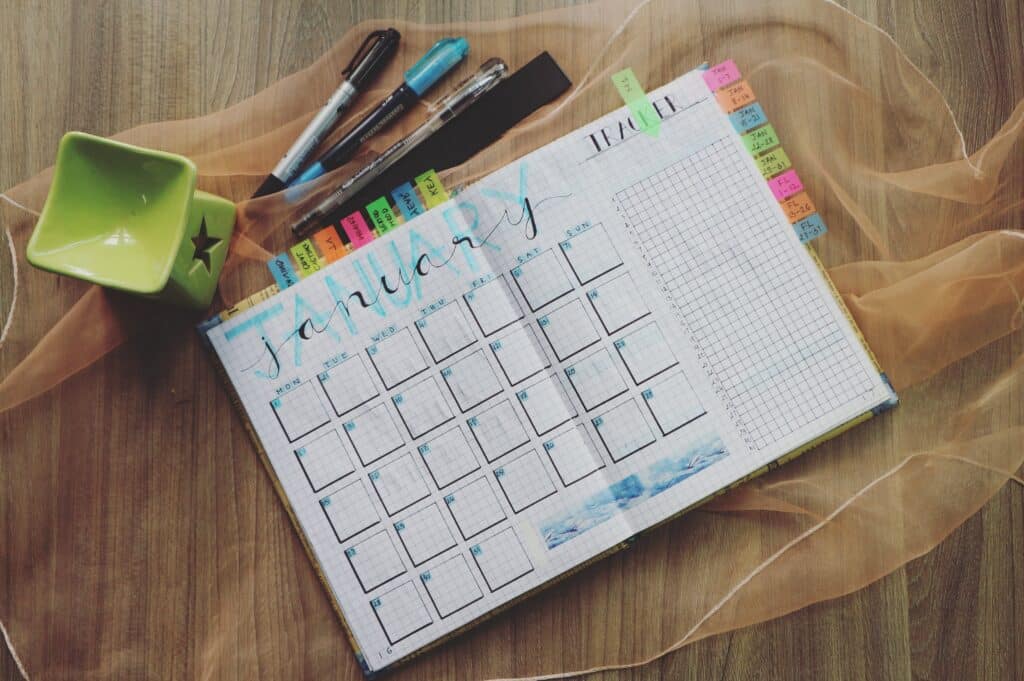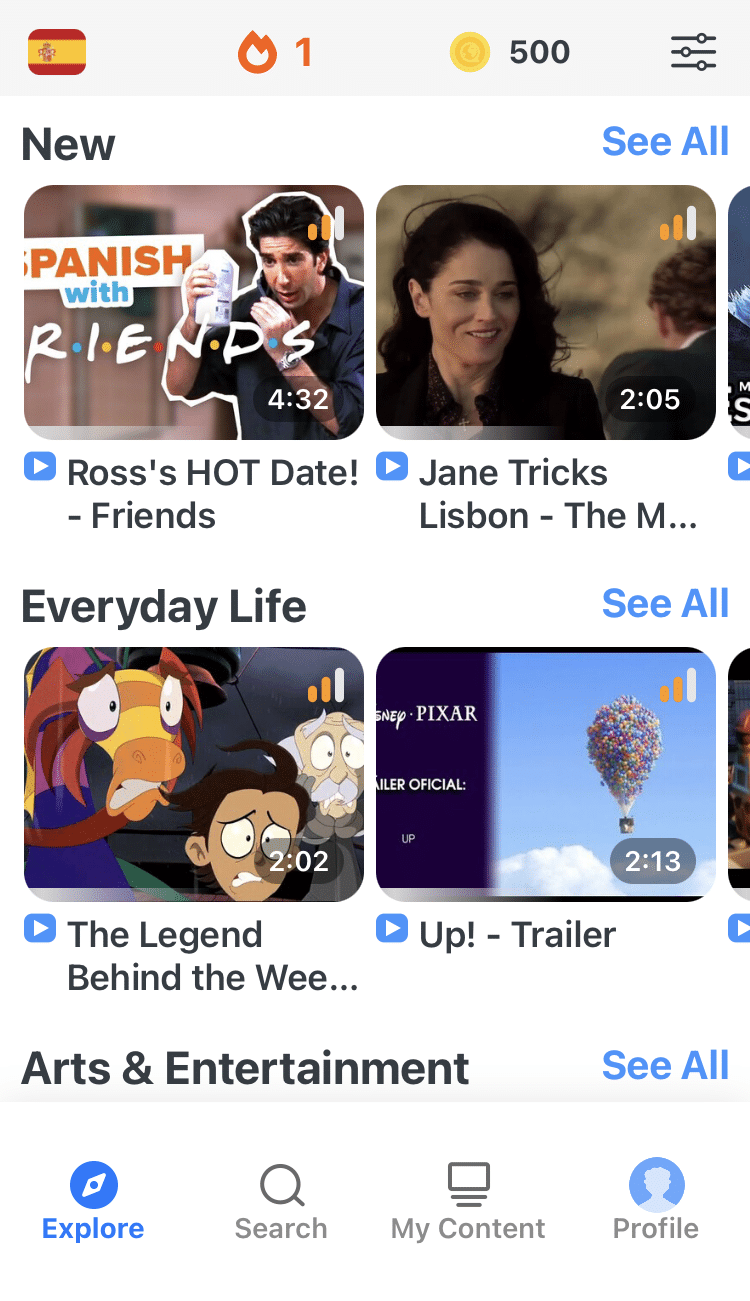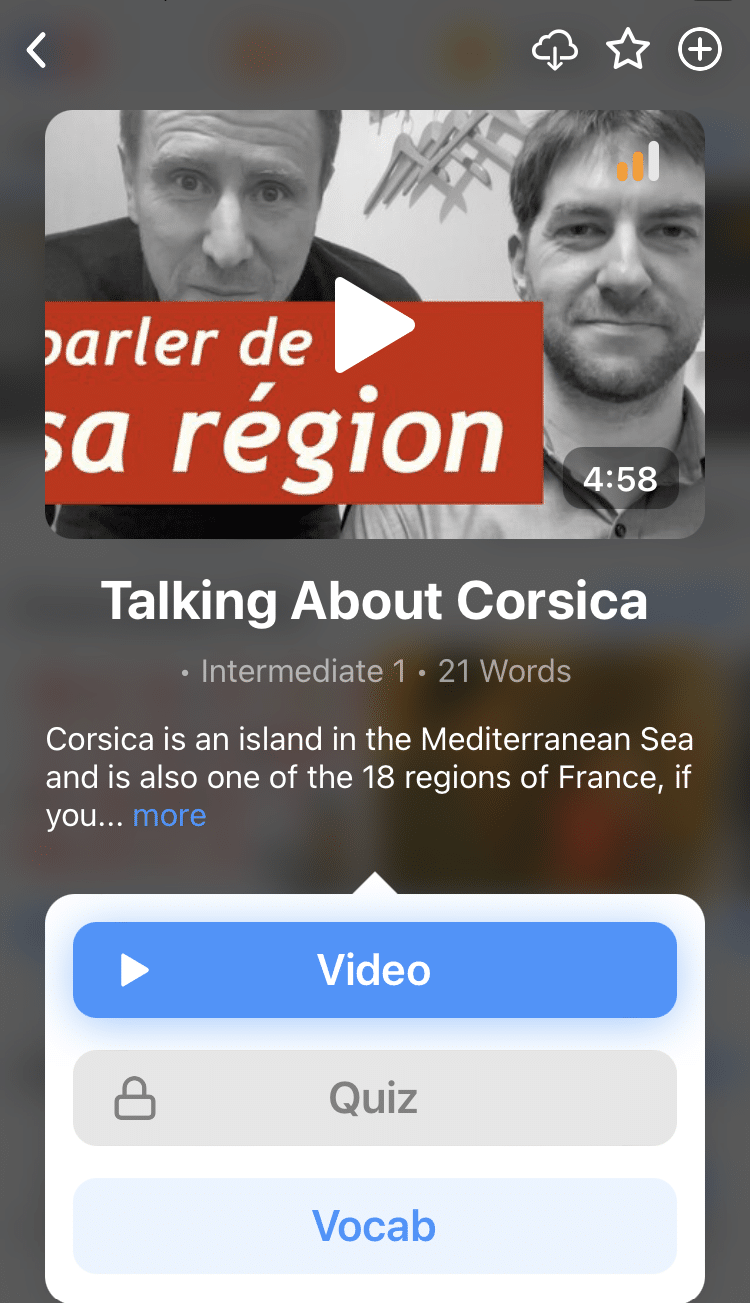
How to Learn a Language in 3 Months (as Much as Possible)
There’s more than one way to learn a language quickly and effectively.
It’s not about having a natural talent for languages or taking the most expensive course.
It’s about adopting the right language learning mindset and putting energy into your studies.
In this post, we’ll explore nine ways to learn a language in three months.
Contents
- 9 Tips to Learn Any Language in 3 Months
- 1. Take a 3-Month Language Immersion Trip
- 2. Use Your Target Language Daily
- 3. Continually Monitor Progress and Make Each Month More Challenging
- 4. Prioritize Input During the First Month
- 5. Stop Translating from Your Native Language
- 6. Watch Hours of Video Content in Your Target Language
- 7. Watch and Interact with Content Slightly Above Your Current Level
- 8. Start Watching Content Without English Subtitles
- 9. Incorporate All Four Language Skills in Your Study Routine
- Can You Really Learn a Language in 3 Months?
- How to Keep Learning After 3 Months
- And One More Thing...
Download: This blog post is available as a convenient and portable PDF that you can take anywhere. Click here to get a copy. (Download)
9 Tips to Learn Any Language in 3 Months
1. Take a 3-Month Language Immersion Trip
Immersion learning is popular for a reason: It works.
You’ll have daily opportunities to strengthen your speaking and listening skills.
And you’ll also have an unrivaled chance to amplify your language skills by learning about the culture.
Before starting an immersion trip, do a bit of initial research into your target language.
Learning strategies can differ greatly depending on how closely related your target language is to your first language or one that you already speak well.
So, if you’re heading off to spend three months in France and your native language is English, start by brushing up on the similarities in sounds and word parts between your two languages.
If you’re studying Chinese or Arabic, on the other hand, start by learning about the most challenging differences between them, like their written scripts and difficult sounds.
Then fasten your seat belt, put your seat back in the upright position and prepare for takeoff.
At-home alternative: living room language immersion.
Jumping up and spending three months in a foreign country might not accommodate everyone’s schedule, budget or life all of the time. But thankfully there are a few substitutes that offer a viable alternative for the most motivated and dedicated.
Check out this post to see how you can take advantage of the 21st century’s digital and analog hacks to create a language immersion environment without leaving home.
2. Use Your Target Language Daily
In your first month, your main objectives are learning to recognize words and phrases in your language.
And overcoming the initial anxiety and discomfort of speaking and starting to use your language right away.
So, here’s your game plan:
- Begin with a basic vocabulary list and start learning the essentials of everyday communication immediately.
- Hang out in parks, cafes and restaurants, spending as much time as you can listening to people talking in public places.
- Immediately start watching TV, movies and other videos to see and hear what your new vocabulary actually sounds like and how it’s used.
- Watch children’s shows where the characters speak slowly and articulately about practical topics like shapes, colors and animals. Muzzy BBC has created animated video series for children that teach a variety of languages, and it’s a great option for adults who enjoy going the fun and colorful route.
- Put yourself in situations where you have to navigate typical customer service conversations.
- Seek out at least one conversation partner early in your first month who has the patience to have slow, simple conversations with you as you build your skills.
The most important thing is that in your first month, you make mistakes freely and overcome your speaking anxiety.
Each mistake is a crucial step in your learning process.
3. Continually Monitor Progress and Make Each Month More Challenging
By the start of the second month, you should have a few hundred words and several dozen handy phrases you’re able to use confidently in one-on-one conversation.
Take a moment to congratulate yourself on your first linguistic baby steps, and get ready to break into a jog in your second month with these steps:
- As soon as you feel like you’re understanding a (slight) majority of what you hear on your children’s shows or other beginner TV shows, raise the bar.
- Try out some documentaries and familiar animated films dubbed into your target language. The documentaries will usually employ a slow, exaggeratedly articulate speech that’s easier for learners to understand, and revisiting your favorite childhood Disney movies will help your comprehension by letting you hear your target language in a very familiar context.
- As your vocabulary grows, pay closer attention to grammar and basic rules that will help you be better understood. Refer to a good book or website to learn basics like the past tense or noun gender, but try to do most of your learning by actively paying attention to native speakers and making mental notes about when they use different verb forms or articles.
- Strive to have new and different conversations every day—repeating the same coffee order every morning is good for warming up, but it doesn’t count as “learning” anymore when you’re just repeating it over and over again.
4. Prioritize Input During the First Month
Input-based learning is the priceless result of immersion (at home and abroad).
You get to soak your brain in linguistic material every day, and opportunities to listen and speak are unlimited.
Since by now you should be completely unfazed by making mistakes, push yourself harder and abandon your remaining conservative impulses.
In the beginning stages, build up the basics.
The basics include recognizing and understanding spoken sounds, using your guidebook phrases and working towards mastering the basic vocabulary of about 500 words you need to navigate everyday life successfully.
Here are some tips for this step:
- Start out with Duolingo or a flashcard app like Memrise to build your basic vocabulary, and be sure to practice every day—even if it’s only for a few minutes. You need to start building a habit at this stage.
- Soak your brain in the sounds of your language. Explore language learning channels on YouTube, watch simple children’s shows and listen to podcasts.
- Start speaking the language daily within your first week. You can find conversation exchange partners on sites like iTalki or ConversationExchange.com.
- Read a Wikipedia page about your hometown, your favorite band or your professional field. Use your familiarity with the subject to learn as many words as possible in context and look up the rest.
By the end of the first month, you should have rooted out the parts of your routine that aren’t working for you, identified the areas that challenge you most, and gone Googling for extra online resources to help get the language down.
5. Stop Translating from Your Native Language
By now you’re used to speaking your target language every day.
Even though you still make lots of mistakes and don’t understand everything, you get the gist of what’s being said more often than not.
Especially when someone’s speaking to you clearly without too much background noise or other distractions.
Now you can focus on applied learning—especially in the third month.
You’ve been soaking up the language for about two months and practicing it as you go, but now it’s time to start really using it organically like a native speaker would.
Here’s what you’ll be doing:
- Totally shut down your first language, both inside and outside your head. Switch all your electronics to the language you’re learning, forego your favorite English-language series, go on a social media hiatus and strive to think in your target language whenever possible.
- Soak your ear in your language every single day. Watch TV, listen to the radio and continue eavesdropping in public parks.
- Strive to find TV and video content that challenges you. If you understand more than two-thirds or three-fourths of whatever you’re watching or listening to, it’s time to bump up to the next level.
- Most importantly, seek out conversation at every turn. Find as many one-on-one conversation partners as will have you. And when you’re feeling extra ambitious, sit down in a small group conversation and do your best to offer some on-topic interjections while you follow along.
After three months of immersion, some learners will still struggle to understand rapid native speech or to express their thoughts clearly, while others may have more trouble reading instructions or writing texts.
That’s normal!
Remember that your goal was never to be perfect at the end of three months.
Check back in with the goals you set before starting, then give yourself a giant pat on the back for the past three months.
6. Watch Hours of Video Content in Your Target Language
If you like the structure of a formal course but relish the freedom of individual study, learning online could be right for you.
If you need the flexibility of studying whenever your hectic schedule coughs up 20 free minutes or if you can’t justify spending hundreds of dollars on language courses, it’s time to think about learning a language online.
FluentU is one example of an online language program that also focuses on immersion-based learning.
With FluentU, you hear languages in real-world contexts—the way that native speakers actually use them. Just a quick look will give you an idea of the variety of FluentU videos on offer:

FluentU really takes the grunt work out of learning languages, leaving you with nothing but engaging, effective and efficient learning. It’s already hand-picked the best videos for you and organized them by level and topic. All you have to do is choose any video that strikes your fancy to get started!
Each word in the interactive captions comes with a definition, audio, image, example sentences and more.
Access a complete interactive transcript of every video under the Dialogue tab, and easily review words and phrases from the video under Vocab.
You can use FluentU’s unique adaptive quizzes to learn the vocabulary and phrases from the video through fun questions and exercises. Just swipe left or right to see more examples of the word you're studying.

The program even keeps track of what you’re learning and tells you exactly when it’s time for review, giving you a 100% personalized experience.
Start using the FluentU website on your computer or tablet or, better yet, download the FluentU app from the iTunes or Google Play store. Click here to take advantage of our current sale! (Expires at the end of this month.)
Once you’ve spent a few weeks calibrating your ear to recognize the sounds and words of your target language and have tried it out yourself in a few Skype sessions, it’s time to start putting your language to work.
7. Watch and Interact with Content Slightly Above Your Current Level
In your second month, fast-track language learners can bump up from the first level of beginner videos to the second.
- Start challenging your ears by watching some beginner-friendly videos without subtitles. Don’t worry about understanding every single word, but do strive to follow the main ideas and the flow of the conversation.
- Beef up your vocabulary by developing a reading habit in your target language. You can find tons of recommendations here.
- Aim to speak your language for an hour or more multiple times a week (or more whenever possible). If you’re getting burnt out on Skype exchanges, try finding local language exchanges through websites and social networks like Meetup and Couchsurfing.
- You could also consider finding a language tutor for extra practice. Verbling and italki are great places to start finding tutors. They allow you to explore hundreds upon hundreds of language teachers from all over and find the one who’s perfect for you.
In the second month, you’ll want to find as much conversation time as possible alongside your continued study through video and vocabulary lessons.
This should be the period where you feel that your vocabulary and listening comprehension both take off, preparing you to jump into the deep end in your third month.
8. Start Watching Content Without English Subtitles
After two months, you should be more comfortable hearing and understanding your target language.
Pushing through to the intermediate level will depend on constantly and actively exercising your language muscles and doing heavier lifting every week.
- Start watching intermediate-level content, and make a point to watch videos on multiple topics (like arts and entertainment, business and health and lifestyle) and all formats (such as music videos, news and TV shows).
- Turn off the English subtitles. After watching each video once with the target language subtitles alone, watch again with all the subtitles off (if the platform you’re using offers this feature).
- Take notes and learn new words as you go.
- Use your active skills every single day. Speak or write in your language as often as possible to exercise the part of your brain that produces (rather than interprets) language. For feedback on your writing from native speakers, try a penpal exchange site like Lang-8. LingQ is another great online practice option that provides you with the support of native speakers, who can give you feedback on your writing or pronunciation.
- Find a series in your language to get way too into. Whether it’s a sitcom, drama or thriller, getting emotionally involved in the characters and their storylines helps your brain process the language more naturally and gives you a fun way to use your language skills.
9. Incorporate All Four Language Skills in Your Study Routine
Sometimes you’re your own best teacher.
Cherry-picking the best parts of existing programs, websites, apps, books, podcasts and social networks to design an individual learning plan can be the best way to go.
You know how you learn best, but keep in mind that you’ll want to address a few key areas if you want to reach overall competence and comfort with your language.
Focus on training yourself in your four main linguistic skills:
1. Listening. A good listener is a good language learner. If you hope to use a language effectively, you’ll need to train your ear and brain to recognize things like unfamiliar vowels and identify where one word ends and a new one begins in everyday speech.
2. Speaking. Use it or lose it. As you listen and take in more linguistic input, using that new knowledge to form your own words, sentences and conversations is the practical application that makes the learning stick.
3. Reading. The emphasis on reading in a second language will differ from learner to learner. For some, learning to read captions and public signs will suffice, while others may want to be able to follow a trending Twitter hashtag or read the latest political news in their target language.
4. Writing. Like reading, the amount of time you devote to writing in a foreign language will differ based on your learning style and preferences. For most, chatting on Facebook and keeping a daily journal are good ways to ensure you practice your active skills every day.
Can You Really Learn a Language in 3 Months?
The short answer: yes, you can learn a language (to around a B1 level) in three months depending on your time commitment and learning strategies.
Before embarking on your three-month mission, you’ll need to set reasonable, concrete goals. Instead of saying you want to reach “fluency,” try to define your goals in terms of linguistic skills you’d like to be able to perform 90 days from now.
Are you looking to be able to have pleasant everyday conversations? Read the news? Make new friends? Give a rousing speech, pen a great novel or pass through society masquerading as a native speaker?
Form these goals in terms of your four core language skills—listening, speaking, reading and writing—and on linguistic actions rather than arbitrary benchmarks.
For example, being able to talk to strangers at the bar—rather than something like learning 500 vocabulary words or memorizing the past perfect tense.
Most learners who are able to study their language full-time (or close to it) for three months can reasonably aim to:
- Navigate everyday conversations successfully
- Understand the majority of what they hear
- Express themselves clearly in simple terms
- Engage with media like TV and newspapers
Every learner and situation is different. What’s important is that you focus on your defined goals, use your language every day and take an approach that works for you as an individual learner.
How to Keep Learning After 3 Months
Regardless of the method you choose, your language learning will hardly be done after three months.
After those first three months, you’ll still find yourself frustrated that you can’t understand what’s being said at times. You might find yourself speaking beautifully and confidently one day only to return to stammering and struggling the next.
Even though you can certainly learn a language in three months, the truth is that you’re never really finished.
As you continue on your language learning journey, remember to use the same principles discussed here to keep building on your progress.
Keep watching TV and movies, and use your favorite websites and apps for refreshers. And, above all, keep using your language, listening to it and speaking it whenever you can.
If done right, learning a language in three months will just be the beginning of a lifelong linguistic journey.
And the benefits of this experience will continue to grow throughout your multilingual life!
Download: This blog post is available as a convenient and portable PDF that you can take anywhere. Click here to get a copy. (Download)
And One More Thing...
If you dig the idea of learning on your own time from the comfort of your smart device with real-life authentic language content, you'll love using FluentU.
With FluentU, you'll learn real languages—as they're spoken by native speakers. FluentU has a wide variety of videos as you can see here:
FluentU has interactive captions that let you tap on any word to see an image, definition, audio and useful examples. Now native language content is within reach with interactive transcripts.
Didn't catch something? Go back and listen again. Missed a word? Hover your mouse over the subtitles to instantly view definitions.
You can learn all the vocabulary in any video with FluentU's "learn mode." Swipe left or right to see more examples for the word you’re learning.
And FluentU always keeps track of vocabulary that you’re learning. It gives you extra practice with difficult words—and reminds you when it’s time to review what you’ve learned. You get a truly personalized experience.
Start using the FluentU website on your computer or tablet or, better yet, download the FluentU app from the iTunes or Google Play store. Click here to take advantage of our current sale! (Expires at the end of this month.)



